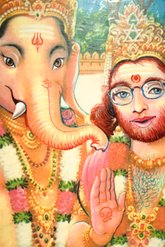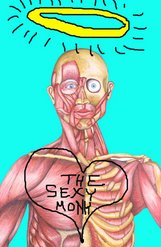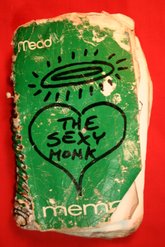In 1997, I had a job creating medical illustrations for The International Museum of Surgical Science. The I.M.S.S. is one of Chicago's hidden wonders (you can find their web site at:
http://www.imss.org/ )-a rambling mansion on Lake Shore Drive packed to the rafters with strange stuff like antique x-ray machines, Napoleon's death mask, and a collection of stag-horn kidney stones. When I worked there, our visitors consisted mostly of venerable old surgeons and a few goth kids looking for gore. This is a shame, because the objects displayed there are just as exciting, surreal, and thought-provoking as anything at the modern art museum. If whats on display is too tame for you, get them to take you down into the basement where they keep the really gross stuff. I loved working there, hunched over my drawing board as the radio played and the snow beat against the windows. When I left, the museum allowed me to keep my original illustrations for my portfolio, so I can present a few of them for you here. All of these drawings were designed to be displayed next to antique surgical instruments in order to show their use, so many of them do not make sense on their own. However, there are three sets of pictures that I feel will hold together with a little explanation. This first set of illustrations concerns the process of bloodletting as it was performed in the 19th century:

Drawing 1-For most of recorded history (from before the ancient Greek civilization to the late 19th century,) people believed that the health of the body depended on the balance of four humors (essential fluids)-blood, phlegm, black bile, and yellow bile. A sharp increase or decrease in any of these humors, the idea went, would result in illness. Thus, a doctor's role as a healer was primarily to bring these humors back into balance. A prescription might include vigorous exercise to induce the patient to "sweat" out disease, the ingestion of a potion to induce vomiting or diarrhea, or a visit to a local barber-surgeon who would cut the patient in order to let out the "bad" blood. Barbers carried out basic surgeries, because they were the often the only people in a town who would reliably have access to sharp instruments. In the classic barber's pole, the red represents blood and the white represents the tourniquet used in the bloodletting process. The most popular sites for bloodletting were two areas where the skin is usually thin and the veins lie close to the surface: the side of the neck and the small of the back.

Drawing 2-Prior to the 19th century, the breaking of the skin for bloodletting was usually accomplished in one of two ways: with a lancet (small surgical knife) or the application of leeches. This drawing shows a device called a scarificator being used. A scarificator consisted of several cat's-claw-shaped blades in a spring loaded metal box. When a button on the top or side of the box were pressed the claws swept out in a small arc and scored the skin. Because if their construction, the scarificators were almost impossible to keep clean, and blood and bits of skin built up inside them. This served to hasten the spread of disease from one patient to another.

Drawing 3-The skin has been scored, now the wound will be sucked to draw out the blood.

Drawing 4-The veins that have been scored will not bleed very much (arteries have a much greater blood pressure,) so suction must be applied to draw out the amount of blood desired. In a treatment of this type, blood was usually drawn from a patient until they fainted. Following a horseback riding accident, 4 pounds (1.7 liters) of blood was drawn from George Washington by his physician, Dr. Benjamin Rush. This treatment is thought to have weakened him greatly, hastening his death from a throat infection. In this drawing, the suction is being provided by a plunger attached to a glass bell. In an earlier version of this treatment a small fire was lit inside of a glass bell-the open end of the bell attached to the patients skin. The fire consumed the oxygen in the bell, creating suction on the wound. This resulted in the fire being doused by the blood and many painful burns. A few years after the bell and plunger method of drawing blood was developed, the entire practice of bloodletting ceased as bacteria and not humor imbalance were proven to be the cause of disease. Next time: anatomy charts from my student days in Chicago.
 Drawing 1-For most of recorded history (from before the ancient Greek civilization to the late 19th century,) people believed that the health of the body depended on the balance of four humors (essential fluids)-blood, phlegm, black bile, and yellow bile. A sharp increase or decrease in any of these humors, the idea went, would result in illness. Thus, a doctor's role as a healer was primarily to bring these humors back into balance. A prescription might include vigorous exercise to induce the patient to "sweat" out disease, the ingestion of a potion to induce vomiting or diarrhea, or a visit to a local barber-surgeon who would cut the patient in order to let out the "bad" blood. Barbers carried out basic surgeries, because they were the often the only people in a town who would reliably have access to sharp instruments. In the classic barber's pole, the red represents blood and the white represents the tourniquet used in the bloodletting process. The most popular sites for bloodletting were two areas where the skin is usually thin and the veins lie close to the surface: the side of the neck and the small of the back.
Drawing 1-For most of recorded history (from before the ancient Greek civilization to the late 19th century,) people believed that the health of the body depended on the balance of four humors (essential fluids)-blood, phlegm, black bile, and yellow bile. A sharp increase or decrease in any of these humors, the idea went, would result in illness. Thus, a doctor's role as a healer was primarily to bring these humors back into balance. A prescription might include vigorous exercise to induce the patient to "sweat" out disease, the ingestion of a potion to induce vomiting or diarrhea, or a visit to a local barber-surgeon who would cut the patient in order to let out the "bad" blood. Barbers carried out basic surgeries, because they were the often the only people in a town who would reliably have access to sharp instruments. In the classic barber's pole, the red represents blood and the white represents the tourniquet used in the bloodletting process. The most popular sites for bloodletting were two areas where the skin is usually thin and the veins lie close to the surface: the side of the neck and the small of the back.
 Drawing 2-Prior to the 19th century, the breaking of the skin for bloodletting was usually accomplished in one of two ways: with a lancet (small surgical knife) or the application of leeches. This drawing shows a device called a scarificator being used. A scarificator consisted of several cat's-claw-shaped blades in a spring loaded metal box. When a button on the top or side of the box were pressed the claws swept out in a small arc and scored the skin. Because if their construction, the scarificators were almost impossible to keep clean, and blood and bits of skin built up inside them. This served to hasten the spread of disease from one patient to another.
Drawing 2-Prior to the 19th century, the breaking of the skin for bloodletting was usually accomplished in one of two ways: with a lancet (small surgical knife) or the application of leeches. This drawing shows a device called a scarificator being used. A scarificator consisted of several cat's-claw-shaped blades in a spring loaded metal box. When a button on the top or side of the box were pressed the claws swept out in a small arc and scored the skin. Because if their construction, the scarificators were almost impossible to keep clean, and blood and bits of skin built up inside them. This served to hasten the spread of disease from one patient to another.
 Drawing 3-The skin has been scored, now the wound will be sucked to draw out the blood.
Drawing 3-The skin has been scored, now the wound will be sucked to draw out the blood.
 Drawing 4-The veins that have been scored will not bleed very much (arteries have a much greater blood pressure,) so suction must be applied to draw out the amount of blood desired. In a treatment of this type, blood was usually drawn from a patient until they fainted. Following a horseback riding accident, 4 pounds (1.7 liters) of blood was drawn from George Washington by his physician, Dr. Benjamin Rush. This treatment is thought to have weakened him greatly, hastening his death from a throat infection. In this drawing, the suction is being provided by a plunger attached to a glass bell. In an earlier version of this treatment a small fire was lit inside of a glass bell-the open end of the bell attached to the patients skin. The fire consumed the oxygen in the bell, creating suction on the wound. This resulted in the fire being doused by the blood and many painful burns. A few years after the bell and plunger method of drawing blood was developed, the entire practice of bloodletting ceased as bacteria and not humor imbalance were proven to be the cause of disease. Next time: anatomy charts from my student days in Chicago.
Drawing 4-The veins that have been scored will not bleed very much (arteries have a much greater blood pressure,) so suction must be applied to draw out the amount of blood desired. In a treatment of this type, blood was usually drawn from a patient until they fainted. Following a horseback riding accident, 4 pounds (1.7 liters) of blood was drawn from George Washington by his physician, Dr. Benjamin Rush. This treatment is thought to have weakened him greatly, hastening his death from a throat infection. In this drawing, the suction is being provided by a plunger attached to a glass bell. In an earlier version of this treatment a small fire was lit inside of a glass bell-the open end of the bell attached to the patients skin. The fire consumed the oxygen in the bell, creating suction on the wound. This resulted in the fire being doused by the blood and many painful burns. A few years after the bell and plunger method of drawing blood was developed, the entire practice of bloodletting ceased as bacteria and not humor imbalance were proven to be the cause of disease. Next time: anatomy charts from my student days in Chicago.



No comments:
Post a Comment